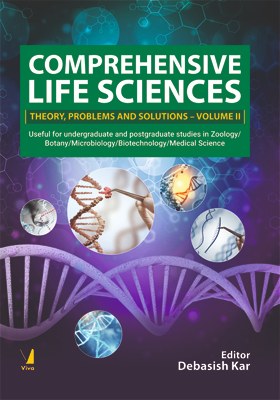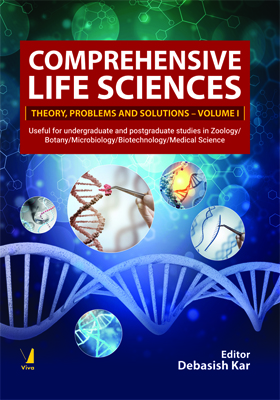Viva CatchUp Biology, 2/e
Viva CatchUp Biology, 2/e
₹535.50 ₹595.00 Save: ₹59.50 (10%)
Go to cartISBN: 9788130912387
Bind: Paperback
Year: 2016
Pages: 224
Size: 153 x 229 mm
Publisher: Scion Publishing Limited
Published in India by: Viva Books
Exclusive Distributors: Viva Books
Sales Territory: India, Nepal, Pakistan, Bangladesh, Sri Lanka
Reviews:
Reviews by Readers:
"... extremely useful at university, a very in depth book, just what's required."
"I have enjoyed reading this book and have found it highly informative. I have studied Biology in a formal context, but this was some years ago. I bought this book in order to better inform my grasp of biology before applying for a Medical Degree."
Description:
Viva CatchUp Biology covers the basic principles and concepts in biology that you will need if you are studying medicine or a related subject, or one of the biomedical sciences. The book focuses on human biology and covers:
- the basic molecules of life, such as proteins, carbohydrates, nucleic acids
- cells, tissues and processes, including energy metabolism, cell division, epithelial and connective tissues
- the key mammalian systems, for example, homeostasis, the endocrine, respiratory and digestive systems
Throughout the book the authors highlight clinical examples so that you can see the relevance of basic biology to your course. The book also contains questions (and answers) so that you can test your understanding of the subject as you work through the book. This new edition features two new chapters on microorganisms and on genetic disease. Viva CatchUp Biology is the ideal book to refresh your understanding of the basic concepts of biology.
Target Audience:
People interested to have basic understanding of biology.
Contents:
Preface • Acknowledgements
The molecules of life
Chapter 1: Water and life • The properties of water • Water in the human body • Test yourself
Chapter 2: Proteins • Introduction • Primary structure • Secondary structures • Tertiary structure • Quaternary structure • Domains • Functions of proteins • Conformational change • Test yourself
Chapter 3: Carbohydrates • Introduction • Monosaccharides • Glycosidic bond • Polysaccharides • Glycoconjugates • Functions of carbohydrates • Test yourself
Chapter 4: Lipids • Introduction • Fatty acids • Triglycerides and phospholipids • Cholesterol • Functions of lipids • Test yourself
Chapter 5: Nucleic acids and genes? Introduction • DNA and RNA • DNA synthesis • RNA synthesis • The genetic code • Protein synthesis • Introns and exons • Regulation of gene expression • Test yourself
Cells and tissues
Chapter 6: The cell • Introduction • Eukaryotic cells • Cell specialisation • Test yourself
Chapter 7: Microorganisms • Introduction • Bacteria • Viruses • Fungi • Other infectious agents • Treatment of infectious disease • Test yourself
Chapter 8: Energy metabolism • Introduction • The citric acid cycle • Release of energy from fats and proteins • Oxidative phosphorylation • Anaerobic respiration • Test yourself
Chapter 9: Membrane transport • Introduction • Osmosis • Facilitated diffusion • Active transport • Exocytosis and endocytosis • Test yourself
Chapter 10: Cell division and mitosis • Introduction • Cell cycle • Control of cell division • Cell division and differentiation • Test yourself
Chapter 11: Reproduction • Introduction • Sexual reproduction • Fertilisation • Reproductive and therapeutic cloning • Test yourself
Chapter 12: Inheritance • Introduction • Definition of terms • Mutations • Mendelian inheritance • Monohybrid inheritance • Dihybrid inheritance • Linkage • Autosomal and sex-linked genes • Genetic fingerprinting • Evolution by natural selection • Test yourself
Chapter 13: Genetic disease • Introduction • Cystic fibrosis: an autosomal recessive disease • Huntington disease: an autosomal dominant disease • Haemophilia A: an X-linked recessive disease • Asthma: a disease caused by multiple genes • Genetic testing • Gene therapy and genetic diseases • Test yourself
Chapter 14: Epithelial tissues • Introduction • Classification • Adhesion • Test yourself
Chapter 15: Connective tissues • Introduction • Glycosaminoglycans • Fibres • Cells • Test yourself
Chapter 16: Excitable tissues • Introduction • Membrane potential • Muscle • Nerve • Test yourself
Systems
Chapter 17: Homeostasis • Introduction • Regulation of plasma glucose • Thermoregulation • Test yourself
Chapter 18: The endocrine system? Introduction • Types of hormone • Cell signal receptors • Second messenger systems • Endocrine glands • Hypothalamo-pituitary axis • Posterior pituitary • Other endocrine glands • Test yourself
Chapter 19: The nervous system • Introduction • Structure of nervous system • The brain • The spinal cord • Peripheral nervous system • Test yourself
Chapter 20: The cardiovascular system • Introduction • Blood • Plasma • Red blood cells • Platelets • The heart • The circulatory system • Test yourself
Chapter 21: The respiratory system • Introduction • Structure of the respiratory system • Respiration • Gaseous exchange • Control of respiration • Test yourself
Chapter 22: The digestive system? Introduction • Oral cavity • Structure of the GI tube • The stomach • Small intestine and accessory glands • Large intestine • Test yourself
Chapter 23: The reproductive system? Introduction • Male reproductive system • Spermatogenesis • Female reproductive system • Oogenesis and the menstrual cycle • Copulation and fertilisation • Implantation and pregnancy • Birth • Test yourself
Chapter 24: The urinary system • The kidney • The bladder • Test yourself
Chapter 25: The immune system • Immune responses to infection • Inflammation • Lymphocytes and the specific immune response • Diseases of the immune system • Test yourself
Chapter 26: The musculoskeletal system? Introduction • Bone • Regulation of calcium levels • Cartilage • The skeleton • Synovial joints • Muscles and locomotion • Test yourself
Answers to “test yourself” questions • Glossary • Index





